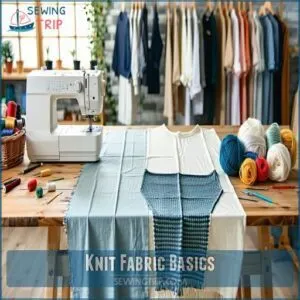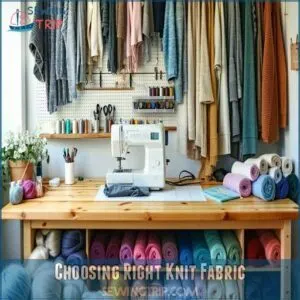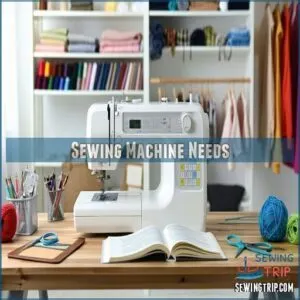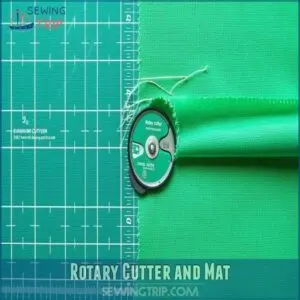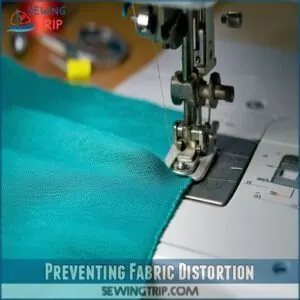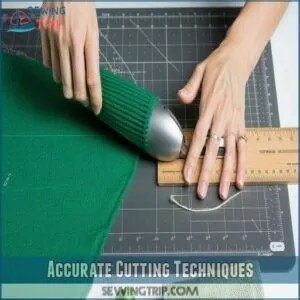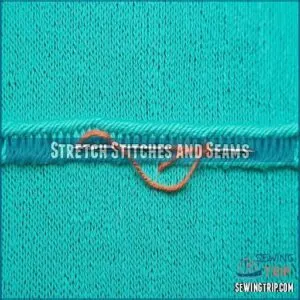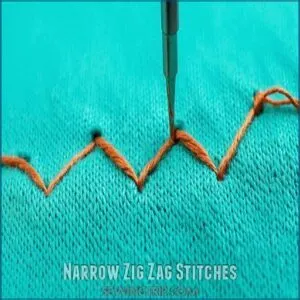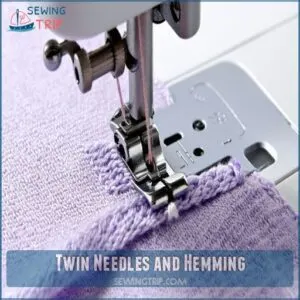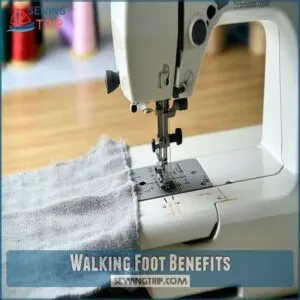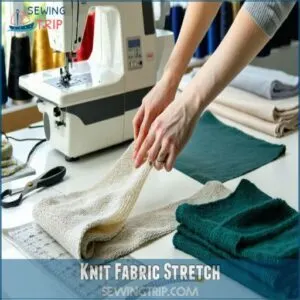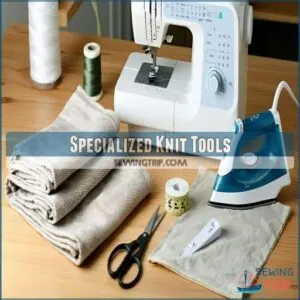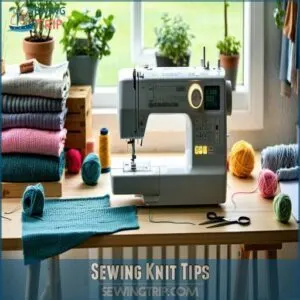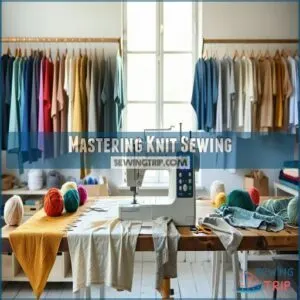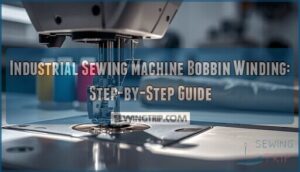This site is supported by our readers. We may earn a commission, at no cost to you, if you purchase through links.
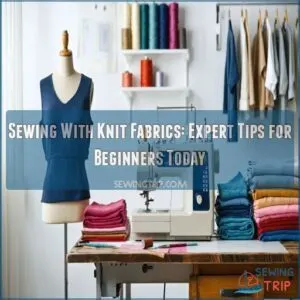
You’ll want to start with the right tools: ballpoint or stretch needles, polyester thread, and a walking foot to keep fabric gliding smoothly.
Cut carefully with a sharp rotary cutter, and use narrow zig-zag stitches to prevent fabric distortion.
Different knits—like rayon spandex, jersey, and ITY—have unique stretch personalities, so test their recovery before diving in. Pro tip: adjust your sewing machine’s foot pressure to keep those seams looking professional.
Ready to discover the secrets of knit fabric magic?
Table Of Contents
Key Takeaways
- You’ll need specialized tools like ballpoint needles, polyester thread, and a walking foot to successfully sew knit fabrics, making your equipment as important as your technique.
- Understanding fabric stretch percentage and recovery is crucial – different knit materials have unique characteristics, so you’ll want to test your fabric’s stretch before cutting and sewing.
- Mastering stretch stitches, particularly the narrow zig-zag stitch, will prevent fabric distortion and ensure your seams remain flexible and professional-looking.
- You’ll transform your sewing skills by practicing with different knit fabric types, reducing machine foot pressure, and avoiding pulling the fabric while sewing to achieve smooth, wearable garments.
Knit Fabric Basics
If you’ve ever wondered about the magic behind stretchy, comfy clothing, get ready to discover the secrets of knit fabrics.
You’ll learn how these flexible wonders are made, what makes them unique, and why they’re a game-changer for sewists of all skill levels, involving knit fabrics.
Types of Knit Fabrics
Wondering how to navigate knit fabrics? Explore the vibrant universe of stretchy, comfortable materials that can transform your sewing projects!
Here’s a quick guide to knit fabric types that’ll have you feeling like a fabric pro:
- Lightweight rayon spandex glides like a dream
- Bamboo rayon offers supreme softness and breathability
- ITY knit brings incredible stretch and recovery
- Jersey fabric: the classic go-to for comfort
- Stretch lace adds delicate elegance to any design
This guide covers various types of knit fabrics, including stretchy and comfortable materials, to help you make informed decisions for your sewing projects.
Characteristics of Knit Fabrics
Every knit fabric tells a unique story through its texture and movement.
Your fabric’s personality comes alive through its weight, fiber blend, and incredible drape.
Understanding knit fabric characteristics means exploring how yarn density creates stretchy, flexible textiles that move with you.
Some knits hug your curves, while others flow like liquid, giving you endless creative possibilities in your sewing journey.
Grainline and Selvedge
The compass of your knit fabric’s personality lies in its grainline and selvedge.
When sewing stretchy fabrics, understanding textile alignment is your secret weapon.
The grainline runs parallel to the selvedge, guiding how your fabric will drape and move. Mastering this orientation guarantees stability and prevents unexpected fabric twists during your creative sewing adventures.
Choosing Right Knit Fabric
Choosing the right knit fabric can make or break your sewing project, so it’s essential to understand the different types and their unique characteristics.
When you’re ready to start sewing, you’ll want to match your fabric’s stretch, weight, and drape to your specific pattern for professional-looking results.
Lightweight Knit Fabrics
After understanding knit fabric basics, you’re ready to explore lightweight knits that’ll make your sewing projects sing. These fabrics are your secret weapon for creating fluid, comfortable garments.
Check out what makes them special:
- Rayon spandex feels like a dream against your skin
- Bamboo rayon spandex offers incredible softness and drape
- Stretch lace adds romantic texture to any design
- ITY knit provides maximum flexibility for dynamic styles
Lightweight knits are your ticket to sewing freedom.
Midweight Knit Fabrics
Shifting gears from lightweight knits, midweight fabrics bring more stability and versatility to your sewing projects.
These fabric powerhouses offer balanced stretch and structure perfect for everyday wear. Check out this quick guide to midweight knit magic:
| Fabric Type | Characteristics | Best Uses |
|---|---|---|
| Cotton Spandex Jersey | Stable, moderate drape | T-shirts, casual tops |
| Double Brushed Poly | Soft, cozy texture | Leggings, comfortable pants |
| Liverpool | Structured, minimal stretch | Fitted dresses, skirts |
Heavyweight Knit Fabrics
When diving into heavyweight knit fabrics, you’ll discover a world of cozy, substantial textiles perfect for winter wear and statement pieces.
These dense weaves offer unique challenges and opportunities for sewists looking to level up their skills.
Check out these key heavyweight knit fabrics:
- Sweatshirt fleece: ultimate comfort and warmth
- Polar fleece: super soft and insulating
- French terry: stylish and versatile
- Ponte de roma: structured and elegant
- Thick knits: perfect for cold-weather garments
Sewing Machine Needs
Your sewing machine can be your best friend or worst enemy when working with knit fabrics, so it’s essential to set it up right.
You’ll want to focus on three key elements: choosing the correct needle, selecting the right thread, and adjusting your machine’s foot pressure to handle those stretchy, slippery fabrics like a pro.
Correct Sewing Machine Needle
After choosing your perfect knit fabric, it’s time to talk needles.
Your sewing machine’s needle can make or break your project.
Ballpoint and stretch needles are your new best friends.
They glide through knit fabrics, preventing snags and skipped stitches.
Jersey needles work magic for most knits, while stretch needles shine with spandex-heavy fabrics.
Pick wisely!
Thread Options for Knits
Picking the right thread can make or break your knit fabric adventure. Your sewing success depends on choosing threads that complement your fabric’s personality.
Consider these thread options:
- All-purpose polyester thread provides reliable stretch and durability
- Cotton thread prevents potential fabric damage
- Stretch thread moves seamlessly with knit fabric
- Lightweight threads work best for delicate knits
- Matching thread weight to fabric guarantees professional results
When working with polyester fabrics, selecting the right thread is vital for a successful project.
Sewing Machine Foot Pressure
Once you’ve chosen the right thread, tweaking your sewing machine’s foot pressure becomes your secret weapon.
Lighten that presser foot to prevent knit fabric from stretching or warping during sewing.
By reducing pressure, you’ll help the fabric feed smoothly, keeping those stitches neat and your seams looking professional. Your walking foot can be a game-changer here.
Cutting Knit Fabric
When cutting knit fabric, you’ll want to use a sharp rotary cutter and a self-healing cutting mat to guarantee precise, clean edges without stretching or distorting the material.
Mastering the right cutting technique will help you create professional-looking garments that fit and drape beautifully, so take your time and let the fabric’s natural stretch guide your approach to achieve a professional-looking result.
Rotary Cutter and Mat
Your cutting accuracy depends on using the right tools and technique. With a sharp rotary cutter and quality cutting mat, you’ll slice through knit fabrics like a hot knife through butter. Choose a self-healing mat specifically designed for fabric, keeping your blade sharp and your edges clean.
Understanding fabric grain is essential for successful sewing projects.
Pro tip: replace your rotary cutter blade regularly to maintain cutting efficiency and fabric safety.
Preventing Fabric Distortion
Battling fabric roll and stretch? Mastering differential feed on your sewing machine is your secret weapon for preventing knit fabric distortion.
Adjust your machine’s tension and use minimal handling to keep those tricky fabrics in check.
Light pressing techniques and careful manipulation will save you from wavy seams and wonky edges during your sewing adventure.
Accurate Cutting Techniques
With a sharp rotary cutter, you’ll slice through knit fabrics like a pro. Protect your work surface with a sturdy cutting mat, ensuring each cut lands with precision.
Pay attention to the grainline and selvedge—they’re your roadmap to perfect pattern placement.
Measure twice, cut once, and watch your knit project come to life with confidence.
Knit Sewing Techniques
To sew knit fabrics like a pro, you’ll want to master a few special techniques. This starts with choosing the right stitches and tools.
Your home sewing machine can handle knits beautifully when you learn how to work with their unique stretchy nature and choose the right needles and stitches.
Stretch Stitches and Seams
Sewing stretch stitches might seem tricky, but they’re your secret weapon for rock-solid knit fabric seams. These magical stitches keep your garments moving with you, preventing frustrating fabric fails.
To achieve professional results, understanding the stretch stitches is essential for beginners.
- Prevents seam popping during movement
- Allows fabric to stretch and recover
- Creates flexible, durable garment construction
- Accommodates body’s natural range of motion
- Guarantees professional-looking finished edges
Mastering stretch seam techniques transforms your knit sewing game.
Narrow Zig Zag Stitches
After mastering stretch stitches, narrow zig zag stitches become your secret weapon.
Adjust stitch tension and length to prevent fabric distortion while maintaining seam stability.
The 3-step zigzag stitch works magic for knits, creating flexible connections that move with your fabric.
Experiment with stitch density to find your perfect match and watch your knit projects come to life.
Twin Needles and Hemming
Ready to level up your hemming game? Twin needles are your secret weapon for killer knit fabric edges. These magic tools create professional-looking finishes that’ll make your projects pop.
Mastering sewing techniques is essential for achieving a polished look. You can find more information on this topic at sewing techniques.
When working with twin needles, here are a few things to keep in mind:
- Grab a twin needle designed for stretch fabrics
- Adjust machine tension carefully
- Use soft stretch hem tape for stability
- Practice on scrap fabric first
- Choose thread colors that complement your project
Walking Foot Benefits
Ready to take your knit fabric sewing to the next level?
A walking foot is your secret weapon for preventing fabric stretching and ensuring smooth, professional-looking seams that’ll make your projects look like they were sewn by a pro.
Even Feed and Fabric Movement
When sewing stretchy fabrics, your walking foot becomes your secret weapon for fabric flow control.
It helps manage tricky knit fabric movement by ensuring even feeding through your machine’s feed dogs.
With this clever tool, you’ll guide your fabric smoothly, preventing bunching and maintaining consistent stitch quality.
Think of it as your fabric’s personal navigation system.
Preventing Puckering and Stretching
Almost every sewer battles fabric puckering when working with stretchy materials.
By carefully controlling fabric tension, you’ll dodge those pesky wavy seams like a pro.
A walking foot becomes your secret weapon, keeping knit fabrics smoothly gliding under the needle without stretching or distorting.
Mastering this technique transforms frustrating sewing moments into seamless, professional-looking projects every time.
Walking Foot Investment
Every serious sewist needs a walking foot – it’s like a secret weapon for conquering knit fabric challenges.
This game-changing sewing machine accessory guarantees even fabric feed, preventing stretching and puckering while maintaining stitch consistency.
By investing in a walking foot, you’ll transform your knit fabric sewing from frustrating to fantastic, giving you professional-looking results every single time.
Knit Fabric Stretch
When you’re sewing with knit fabrics, understanding stretch is your secret weapon for creating perfectly fitted garments.
By learning how much your fabric can stretch and bounce back, you’ll discover the key to professional-looking results that move and feel amazing.
Figuring Out Stretch Percentage
After mastering your walking foot, understanding stretch percentage becomes your secret weapon in knit fabric sewing. Knowing how far your fabric can stretch opens up a world of possibilities, and using a stretch percentage calculator can simplify the process.
Here’s how to nail stretch calculation:
- Measure fabric at rest
- Stretch fabric fully
- Calculate percentage difference
- Test multiple fabric points
Stretch percentage isn’t just a number—it’s your fabric’s flexibility blueprint.
Returnability and Recovery
Fabric Memory: Your Knit’s Secret Superpower!
Returnability is how well your fabric snaps back after stretching, like a trusty rubber band.
Understanding this elastic recovery helps you choose the right knits for your projects.
| Fabric Type | Returnability | Stretch Percentage | Best Use |
|---|---|---|---|
| Rayon Jersey | Moderate | 50-75% | Flowing Tops |
| Cotton Spandex | High | 30-50% | Fitted Garments |
| Bamboo Blend | Low | 25-40% | Loose Layers |
| Ponte Knit | Very High | 20-30% | Structured Pieces |
This knowledge of Fabric Memory and Returnability is crucial in making informed decisions about your knitting projects, ensuring the best possible outcome.
Working With Different Stretches
Now that you understand returnability, let’s tackle the art of working with different stretches. Think of knit fabrics like stretchy yoga pants – some bounce back instantly, while others need a little coaxing.
Your sewing success hinges on mastering each fabric’s unique stretch personality, which involves understanding stretch fabric sewing techniques.
From lightweight rayon to sturdy ponte, knowing how each fabric moves will transform your knit sewing game.
Specialized Knit Tools
When you’re ready to tackle knit fabric sewing, you’ll want to arm yourself with specialized tools that can make your project smooth and professional.
From ballpoint needles that glide through stretchy fabrics to fusible hem tape that keeps your edges crisp, these tools will transform your sewing experience.
And help you create garments that look store-bought.
Ballpoint and Jersey Needles
When tackling knit fabric, your secret weapon is the right needle selection. Ballpoint and jersey needles are designed with rounded needle tips that glide smoothly through fabric loops, preventing snags and skipped stitches.
Using ballpoint needles is important for achieving professional results. These special sewing machine needles push fibers apart instead of piercing them, ensuring your knit projects look professional and polished every time.
Stretch Needles and Scarf
Diving into stretch needles reveals a world of sewing magic for knit fabrics. Understanding the needle’s unique scarf can transform your stitching game, especially when using sewing knits techniques.
Here’s what makes stretch needles your secret weapon:
- Longer scarf design minimizes pesky skipped stitches
- Ideal for fabrics with high spandex content
- Prevents fabric damage during machine sewing
- Specially engineered for maximum stretch compatibility
- Reduces tension and improves overall stitch quality
Fusible Hem Tape and Web
In the wild world of knit fabric sewing, fusible hem tape is your secret weapon for crisp, professional-looking hems.
Check out this quick guide to choosing and using hem tape like a pro:
| Hem Tape Type | Width | Best For |
|---|---|---|
| Soft Stretch | 1/4" | Lightweight Knits |
| Woven Fusible | 1/2" | Stable Knits |
| Knit Hemming | 3/4" | Heavy Fabrics |
| Narrow Web | 1/8" | Delicate Edges |
Master these hem tape tricks to level up your knit sewing game!
Sewing Knit Tips
When you’re ready to tackle sewing with knit fabrics, you’ll want to master a few key techniques that’ll make your projects smooth and professional.
These sewing tips will help you prevent fabric stretching, hold your thread correctly, and press your seams like a pro, turning potential challenges into sewing successes.
Holding Thread and Starting Sewing
After mastering specialized knit tools, you’ll want to nail those tricky sewing starts.
Threading your machine becomes an art form when working with knit fabrics.
Here’s how to grip your thread and kick off your project like a pro:
- Hold the thread gently when beginning to sew
- Prevent bobbin area thread tangling
- Keep your hand steady near the needle
- Control thread tension from the first stitch
Preventing Fabric Stretch and Pull
When sewing knits, treating the fabric like a delicate dance partner matters.
Don’t pull or stretch your material while guiding it through the machine – let it flow naturally. Understanding sewing stretch techniques is essential for achieving professional results.
Maintain consistent, gentle tension and support the fabric’s weight to prevent unwanted distortion. Your walking foot becomes your secret weapon for keeping everything smooth and stable during your sewing journey.
Pressing Seams and Setting Stitches
Got those seams looking wonky after sewing? Time to master the art of pressing and setting your stitches!
Steam is your secret weapon for knit fabric magic. Here’s how to transform your project from "meh" to magnificent:
- Use a hot steam iron with light pressure
- Let fabric cool completely before moving
- Press seams open or to one side gently
- Avoid dragging iron – lift and place instead
Mastering Knit Sewing
Ready to transform your sewing skills and conquer stretchy, comfy knit fabrics?
You’ll discover that with the right techniques, tools, and a bit of practice, mastering knit sewing isn’t just possible—it’s going to be your new favorite crafting adventure.
Practicing and Improving Skills
Honing your knit sewing skills starts with intentional practice.
Set up sewing drills focused on fabric mastery, experimenting with different knit types and stitch techniques.
Keep a project journal to track your progress and analyze errors.
Start small with simple projects like pillowcases or headbands, gradually challenging yourself with more complex knit fabric designs.
Your confidence will grow with each stitch.
Common Mistakes and Solutions
The fabric’s silent saboteur? Fabric distortion. When sewing knits, you’ll bump into common sewing errors that can make your project look like a DIY disaster.
Stretch control is key: don’t pull or stretch while stitching, use the right needles, and master seam repair techniques. Patience and practice turn those knit fabric issues into smooth, professional-looking creations.
Advanced Knit Sewing Techniques
Once you’ve conquered basic knit sewing, level up your skills with pro techniques that’ll transform your garment construction.
Master these game-changers:
- Explore advanced stretch control using specialized stabilizers
- Experiment with innovative knit interfacing methods
- Practice precision tension techniques for flawless seams
You’ll soon turn fabric distortion fears into confident sewing victories, crafting professional-looking knit garments that showcase your growing expertise.
Frequently Asked Questions (FAQs)
Can you sew knit fabric on a regular sewing machine?
Your regular sewing machine can handle knit fabrics.
Just grab ballpoint needles, adjust your stitch settings, and you’ll be stitching stretchy material like a pro.
With the right tools, sewing knits is totally doable.
What is the best stitch for knit fabrics?
Imagine wrestling a slippery eel versus dancing with a smooth partner – that’s the difference between the wrong and right knit fabric stitch.
A zigzag stitch lets your fabric stretch, preventing thread breakage and keeping seams flexible.
Is knit fabric hard to sew?
Sewing knit fabric isn’t as tricky as it seems!
With the right tools like ballpoint needles and a walking foot, you’ll breeze through projects.
Practice makes perfect, and soon you’ll be crafting stretchy garments like a pro.
Is there a trick to sewing stretchy fabric?
Ever wrestled with fabric that fights back?
Your secret weapon is a walking foot, ballpoint needles, and a stretch stitch.
These tricks help you tame stretchy fabric’s wild personality, turning sewing challenges into smooth sailing.
How do I prevent knit fabric from rippling?
Reduce your machine’s foot pressure, use a walking foot, and choose the right needle.
Don’t pull the fabric while sewing.
Practice with scraps and test different settings to keep your knit fabric smooth and ripple-free.
Whats the best way to finish knit seams?
Use a serger or narrow zigzag stitch to finish knit seams.
If you don’t have a serger, try a stretch stitch on your sewing machine. This prevents fraying and keeps your seams flexible and professional-looking.
Can I alter ready-to-wear knit garments?
You can totally alter knit garments! Grab ballpoint needles, a walking foot, and stretch stitches.
Test on scrap fabric first, and go slow.
Remember, patience is your sewing superpower when tweaking those comfy knits.
How do I fix stretched-out knit edges?
Got stretched-out knit edges? Steam‘s your secret weapon!
Gently press with a hot iron, then let the fabric cool completely.
If that doesn’t work, try stay-stitching close to the edge to restore shape and prevent further stretching.
Why are my knit hems wavy?
Wobbly Woes with Wavy Hems? Stretching fabric while sewing, using incorrect tension, or skipping specialized knit needles can create rippled edges.
Try a walking foot, ballpoint needle, and gentle handling for smoother results.
Conclusion
Don’t let knit fabrics intimidate you—they’re your ticket to sewing freedom!
With practice, you’ll master sewing with knit fabrics like a pro. Remember, every stitch builds confidence, and each project gets easier.
Start small, experiment with different techniques, and don’t fear mistakes. Your skills will grow faster than you imagine.
Grab those stretchy materials, fire up your machine, and turn those fabric dreams into wearable reality. Your wardrobe transformation begins now with practice!
- https://www.wawak.com/Sewing/Needles/Home-Machine/schmetz-stretch-ball-point-home-machine-needles-5pack/?sku=SMNSB15111
- https://www.heatherhandmade.com/16-tips-for-sewing-knit-fabric/
- https://mindymakes.com/how-to-sew-knits-fabric/
- https://www.chalkandnotch.com/sewing-with-knit-fabrics-tips-and-recommendations/
- https://sewpdf.com/blog/choosing-a-stretch-stitch-for-sewing-knit-fabric/

